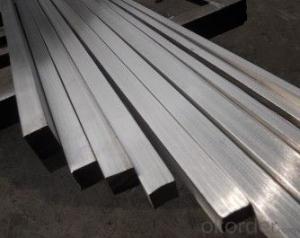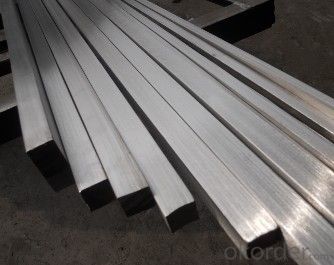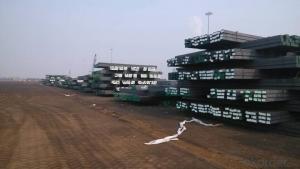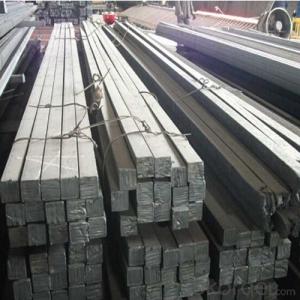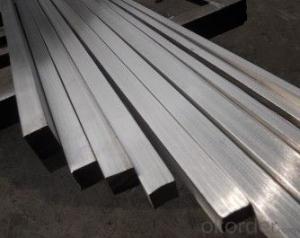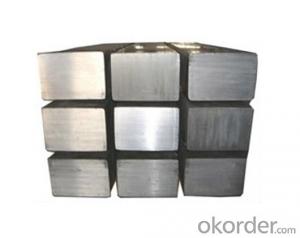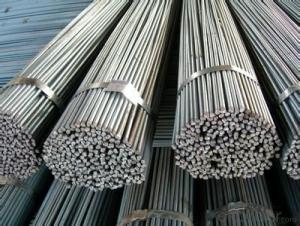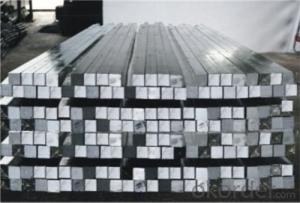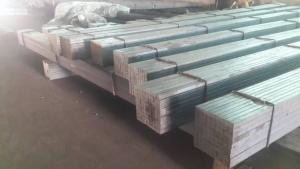16MnSi High Quality Square Steel Bar
- Loading Port:
- Tianjin
- Payment Terms:
- TT OR LC
- Min Order Qty:
- 1000 m.t.
- Supply Capability:
- 100000 m.t./month
OKorder Service Pledge
OKorder Financial Service
You Might Also Like
Product Description:
Product Description:
In the production of steel products, steel is molded and reshaped with different machinery at different temperatures. One process is steel rolling, which involves metal stock passing through a pair of rolls. Rolling produces flat steel sheets of a specific thickness, and the process is classified according to the temperature at which the metal is rolled. If the temperature of the metal is above its recrystallization temperature, or the temperature at which the grain structure of the metal can be altered, then the process is termed as hot rolling. If the temperature of the metal is below its recrystallization temperature, the process is termed as cold rolling.
Like cold rolling, cold drawing is performed at room temperature, but instead of producing a flat object like a coke can, cold drawing makes steel into the form of a wire like the spokes of a wheel or a paper clip. To start the process, Steel is usual hammered and rolled so that it can be fit through a die; a tool that turns the steel mass into a wire. The room temperature steel is pulled through the die which reshapes it into a thinner shape while maintaining the same volume. It is similar to the idea of syrup flowing out of a bottle through a tube in that it changes shape but not volume, but instead of squeezing the metal, it is pulled out. In order to get the wire down to the right diameter, it usually requires more than one pass through different dies.
Colddrawn steel, steel covered carbon steel, excellent carbon steel, alloy structural steel, carbon tool steel, spring steel, bearing steel, tool steel, cold heading steel, free cutting steel, martensite stainless steel; products include all kinds of shapes round, square steel, hexagonal, flat steel and other conventional products, including various special-shaped steel products. In all types of colddrawn steel industry has been widely used, these areas include automotive, machine tools, furniture, standard parts, textile machinery, agricultural machinery, military industry and other industries.
The total assets of more than 40 million, as of the end of 2010 with fixed assets of 34 million, with 60 tons from 5 tons a chain drawing machine 10 sets, horizontal and inverted coiled wire drawing machine 5 sets, steel and plate production line of blasting, high-power ham stove, various straightening machine and cold rolling mill and other major equipment.
Usage/Applications
-The Square Bar is normally used as structure steel.
-Row material for other structure steel like steel angles, channels, I-beams, H-beams, etc…
Packaging & Delivery
-Packing Detail: The products can be packed in bundles by steel wires.
-Marks: We make tag marks and color marks. The tag marks with white background and red company logo will be tied up to each bundle of the products. The information is usually including basic information of products and company and other information requested by customers. As for color marks, we will paint both ends of bundles to make sure that it w
-Delivery Detail: 30~45 working days after receive buyer’s T.T. or L/C.
ill be more convenient for customers to distinguish them from other products.
- Q: How do you use a steel square to determine the angle of a cut?
- To use a steel square to determine the angle of a cut, you need to follow a few simple steps. First, ensure that your steel square is clean and free from any debris or dirt. Place the base of the square firmly against the edge of the material you want to cut, ensuring that it is aligned properly. Then, use the markings on the square to find the desired angle. The most common angle measurements on a steel square are 45 degrees and 90 degrees, but some squares may have additional markings for other angles. Once you have identified the angle, draw a line along the edge of the square using a pencil or marker. This line will serve as a guide for your cut. Finally, using a saw or other cutting tool, carefully follow the marked line to make your cut at the desired angle. It is important to maintain steady control and ensure the saw is properly aligned with the marked line to achieve an accurate cut.
- Q: How to fix the steel Aluminum Alloy
- Aluminium and steel welding now has two processes, one is explosive welding, which relies on the tremendous pressure caused by the explosion to weld the steel and aluminum plate together. The other is a diffusion welding, at a certain temperature, the steel and aluminum contact surface diffusion, diffusion layer is very thin in the joint surface, this time is longer, and the high requirements, generally in the equipment of.Melting welding is not yet implemented, plus transition plate is now a method, not the true sense of the aluminum plate and steel welding, but the transition plate is produced by the above two methods.
- Q: How do you use a steel square for creating accurate box joints?
- To use a steel square for creating accurate box joints, you will need to follow a step-by-step process. Here is how you can utilize a steel square effectively: 1. Start by selecting the appropriate size of steel square for your project. Steel squares are available in various sizes, so choose one that suits the dimensions of your box joints. 2. Measure and mark the desired length of your box joint on the edges of the mating boards. Ensure that the measurements are accurate and aligned properly. 3. Place the steel square against the edge of one of the boards, aligning the square's long side with the marked line for the box joint. Ensure that the square is firmly held against the board to prevent any movement. 4. Using a pencil or a marking knife, trace along the edge of the long side of the steel square, marking the line onto the board. This will create an accurate reference line for your box joint. 5. Repeat the process on the second board, aligning the steel square's long side with the corresponding marked line. Ensure that both boards have the same line marked on them for accurate box joints. 6. Now, adjust the steel square by 90 degrees, aligning the short side of the square with the marked line on the first board. Ensure that the square is securely held against the board. 7. Mark another line on the first board, following the edge of the short side of the steel square. This will create a perpendicular reference line to the first one, completing the box joint layout. 8. Repeat the process on the second board, using the same adjustment and alignment with the steel square as done on the first board. Ensure that both boards have the same perpendicular line marked on them for accurate box joints. 9. With the accurately marked reference lines, you can now proceed to cut the box joints using a saw or a router, following the marked lines precisely. Remember to always double-check your measurements and ensure that the steel square remains firmly in place during the marking process. Accuracy and attention to detail are crucial for creating precise box joints using a steel square.
- Q: How do you use a steel square to mark out parallel lines on curved surfaces?
- In order to mark out parallel lines on curved surfaces using a steel square, a few steps must be followed: 1. The appropriate size steel square should be chosen for the project, taking into consideration the scale and curvature of the surface being worked on. 2. By placing the steel square against the curved surface, ensuring that one edge aligns with the desired starting point of the parallel line, the process begins. 3. To mark the first parallel line, a pencil or marker is used to trace along the other edge of the steel square. 4. The steel square is then slid along the curved surface, aligning the marked line with the desired distance for the parallel lines. 5. This process is repeated by tracing along the other edge of the steel square, marking each parallel line at the desired distance. 6. The sliding and marking of the steel square along the curved surface continues until all the necessary parallel lines have been marked. When working with curved surfaces, it is important to note that the parallel lines may not be perfectly straight due to the curvature. However, the use of a steel square will assist in maintaining a consistent distance between the lines, resulting in a visually pleasing and accurate outcome.
- Q: Can a steel square be used for checking the squareness of a router table top?
- Indeed, the squareness of a router table top can be assessed using a steel square. This tool is widely employed for verifying squareness and yielding precise measurements. Placing the steel square against the table top's edges guarantees their perpendicularity. By contrasting the table top's squareness with the steel square, any deviations or misalignments can be readily detected. This step is indispensable to guarantee the precision and accuracy of the router table since a flawless square table top is vital for attaining consistent and accurate cuts.
- Q: Can a steel square be used for carpentry tasks?
- Yes, a steel square can be used for carpentry tasks. It is a versatile tool that can be used for measuring, marking, and checking angles in carpentry projects. Its durability and precision make it suitable for various tasks, such as laying out and cutting accurate angles, checking for squareness, and marking straight lines.
- Q: What are some common uses for a steel square in metal fabrication?
- A steel square, which is also known as a framing square or carpenter's square, is commonly used in metal fabrication for a variety of purposes. In metal fabrication, a steel square has several common uses including: 1. Accuracy in measuring and marking metal pieces is achieved with a steel square. It ensures precise angles and lines, which are crucial in metal fabrication. 2. Perfectly square corners are ensured by using a steel square in metal fabrication. This allows for accurate and seamless welding or joining of metal pieces. 3. Checking for flatness in metal sheets or plates is done using a steel square. It helps identify any warping or bending in the metal surface, allowing for corrections before further processing. 4. Layout work, which involves marking and positioning various components before assembly, benefits from the straight edges and angles of a steel square. It helps accurately transfer measurements and create templates for cutting or shaping metal pieces. 5. Drafting and designing metal structures or components often involve using steel squares. They aid in creating precise drawings, accurate calculations, and ensuring the final product meets required specifications. 6. Steel squares have a protractor scale that allows for measuring and marking various angles. This is beneficial in metal fabrication, where specific angles are required for cutting, bending, or welding metal pieces. 7. During the setup of machinery in metal fabrication workshops, steel squares are useful. They help align and position machines, ensuring they are level and accurately placed for optimal performance. Overall, a steel square is an essential tool in metal fabrication, providing accuracy, precision, and versatility in various tasks such as measuring, marking, squaring corners, checking flatness, layout work, drafting, designing, angle measurements, and machinery setup.
- Q: The steel structure of 40*80 steel, it is tempered glass top. The steel internal fight foaming agent. But there is rust in the inner surface. Will it affect the safety? How to deal with
- The rust removal on the inner wall of pipe profiles has always been a thorny problem. If the corrosion is not serious, the treatment is usually not done. If you want to anti-corrosion effect is good, but also to go inside the paint corrosion prevention practices, very few.
- Q: Can a steel square be used for marking out tenons?
- Yes, a steel square can be used for marking out tenons. It is a versatile tool commonly used in woodworking for measuring, marking, and checking right angles. The steel square can help ensure accuracy and precision when marking the dimensions and angles required for cutting tenons.
- Q: How do you use a steel square to find the length of a hip rafter?
- To use a steel square to find the length of a hip rafter, you would first measure the length of the common rafter and mark it on the square. Then, align the square with the edge of the hip rafter and adjust the square until it intersects with the marked length on the common rafter. The point where the square intersects the hip rafter will indicate the length of the hip rafter.
Send your message to us
16MnSi High Quality Square Steel Bar
- Loading Port:
- Tianjin
- Payment Terms:
- TT OR LC
- Min Order Qty:
- 1000 m.t.
- Supply Capability:
- 100000 m.t./month
OKorder Service Pledge
OKorder Financial Service
Similar products
Hot products
Hot Searches
Related keywords
